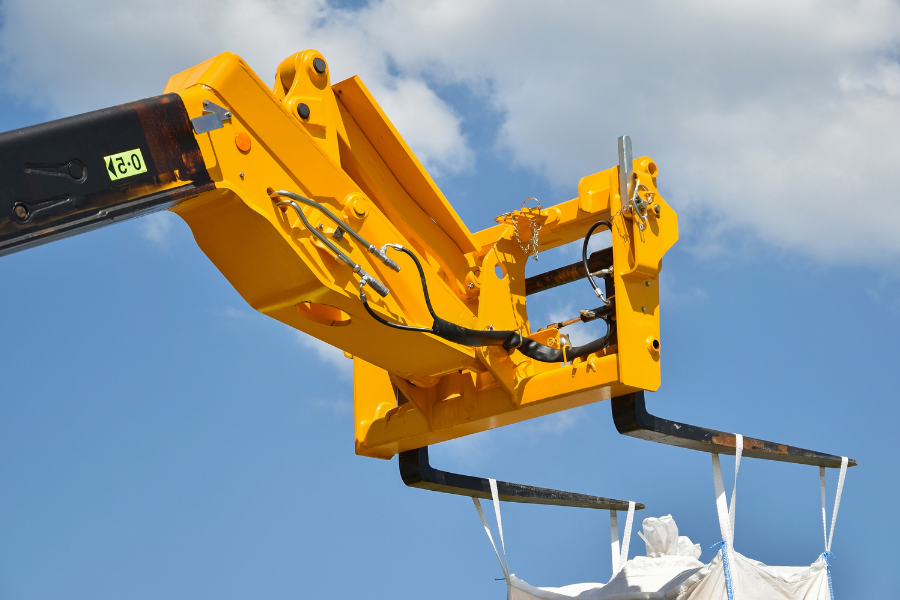Your forklift’s hydraulic system may be the most essential part of the vehicle. Nothing moves without it, and the most important aspect of that system is arguably the forklift hydraulic fluid.
Every lift truck operating on planet Earth has at least one thing in common: they all need hydraulic fluid (sometimes called hydraulic oil). Yup, the hydraulic fluid for pallet jack, hydraulic fluid for telehandler and hydraulic fluid for forklift all serve the same purpose: ensure that the machines can lift and move heavy cargo.
Forklift hydraulic fluid system
Several components must work in tandem to form the hydraulic forklift system. First, the forklift hydraulic fluid is placed and stored in a reservoir tank. The tank is connected to a hydraulic pump that pushes the fluid through a series of hoses. The hoses lead to one of three types of hydraulic cylinders. The first type is the lift cylinder, which controls the raising and lowering of the forks. The second is the tilt cylinder, which enables the forklift mast to lean forward and backward. The third is the power steering cylinder, which makes the forklift easier to steer and really isn’t germane to this article.
A control valve regulates the fluid’s flow and sends it to the correct cylinder. Each cylinder is a hollow tube, open at one end so fluid can enter and closed by a movable piston at the other end.
A forklift hydraulic fluid system works because, at high velocities, liquids act like a solid. It’s why you can skip a stone across the surface of a lake. Liquids can’t compress, meaning they’re not squishy. They must move around things. For example, if you jump into a pool vertically (straight up and down), you easily reach the bottom. This is because your body was narrow with little surface area, and the liquid could easily move around you. However, if you try to enter horizontally, like doing a belly flop, it initially feels like you landed on cement because the liquid can’t compress. A belly flop hurts (a lot) because you tried to enter the pool too quickly and with too much surface area.
Hydraulic systems use this feature to transmit force. When a forklift hydraulic fluid pushes into a cylinder, pressure increases, moving the piston and enabling the forks to lift or tilt. That’s how a relatively minor amount of liquid can lift 1,000 pounds of cargo.
How to check hydraulic fluid
Forklift operators should check the hydraulic fluid as part of their daily forklift inspection before operating the vehicle.
To check the hydraulic fluid, park your forklift in a flat area and lower the forks. The forks need to be low and level because hydraulic fluid is inside the cylinders when they are raised or tilted. This means the fluid level you see in the tank does not accurately depict how much is in the system. With the forks raised, it is easy to overfill the system, which can cause an overflow and potentially damage the machine, something this gentleman discovered the hard way.
Next, find the hydraulic fluid tank. The forklift’s operating manual should include a diagram of its exact location.
Unscrew the cap located on the tank. A dipstick is attached to the underside of this cap. Check the fluid level and compare it to the recommended fill line notched on the dipstick. Some forklifts also have a gauge on the tank to help prevent overfilling.
A few manufacturers use a single hydraulic fluid dipstick across multiple forklift versions, such as cushion vs. pneumatic tire forklifts. As a result, your dipstick may have several fill lines on the front and back, all with different labels. If it looks like your hydraulic fluid is simultaneously dangerously low, exactly right and about to overflow, check the operating manual to see which fill line matches your specific forklift.
How long does hydraulic fluid last?
On average, changing the forklift hydraulic fluid is recommended after every 1,000 hours of operation. Certain models may advise changing sooner or later than 1,000 hours. So, be sure to check the operating manual.
There are also warning signs that let you know when hydraulic fluid needs changing. In addition to a low dipstick reading, indications include:
- Sluggish lifting and tilting.
- Vehicle overheating.
- Dark-colored hydraulic fluid (instead of transparent).
- Hydraulic fluid that smells burnt.
If you notice any of the above signs, check your hydraulic fluid’s level and condition, and refill or change as necessary.
How to change hydraulic fluid
The first step in changing forklift hydraulic fluid, before you even approach the machine, is to be certain that the new fluid matches what is currently in the vehicle. There are many types of forklift hydraulic fluids, including water-based, oil-based and synthetic, with various viscosity grades. The best hydraulic fluid for lift action depends on the type of forklift and how it is used. For example, synthetic fluid helps regulate the temperature in warm and cold environments.
Matching hydraulic fluid is important because, even after draining hydraulic fluid, some of the original fluid remains in the tank. So, always check the forklift’s operating manual for the recommended hydraulic fluid type and grade.
Once you’re confident that the hydraulic fluid in your hand matches what’s in the tank, proceed with the following steps.
- Park in a flat area and apply the parking brake.
- Completely lower the forklift carriage. This is extremely important. If you skipped right to this section, please scroll up to “how to check hydraulic fluid” and discover why (there’s also a fun link).
- Turn off the ignition.
- Find the hydraulic fluid tank and locate the plug near the tank’s base.
- Place a container under this plug. Make sure the container can hold the same amount as the hydraulic fluid tank (the capacity is in the operating manual).
- Remove the plug and give yourself a moment to meditate[1] on the soothing sight and sound of the draining liquid.
- Back to work. Peek inside the empty tank and scan for any debris or buildup. Clean, if necessary.
- Put the plug back in the tank.
- Double-check that the plug is in the tank. Seriously. You will be very upset with yourself if you forget this step.
- Remove the cap on top of the hydraulic fluid tank.
- Fill the tank with hydraulic fluid. Remember to keep a close eye on the gauge as it fills. Slow as it nears the fill line and stop when the tank is full. Do not overfill.
- Clean up any spilled hydraulic fluid, such as if you forgot to put the plug back in the tank.
- Replace the cap, and you’re good to go.
If you wish to avoid the hassle of changing the hydraulic fluid or have other forklift repair and maintenance needs, Texas Motive Solutions is here to help. We can have an experienced technician to your site typically in 24 hours or less.
Please call us at (888) 316-2459 or fill out this form to learn about our services or begin a service request and discover everything we can do for you.


